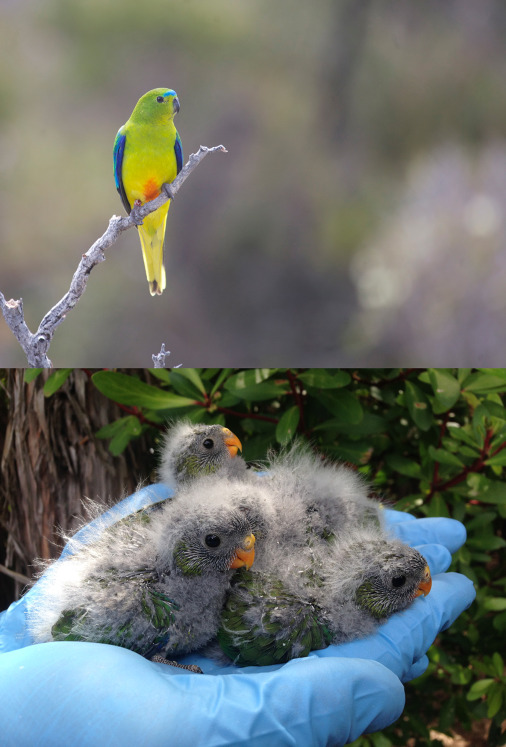ARTICLE AD
Over 80 critically endangered parrots have returned to their breeding ground in Tasmania – the highest number in 15 years.
Only 3 wild female orange-bellied parrots (Neophema chrysogaster) returned from their annual migration to the Australian mainland in 2016. The species was almost declared functionally extinct, despite decades of dedicated breeding programs and research into the colorful bird's conservation.
And while their numbers finally seem to be heading in the right direction, there's still a long way to go.
The audacity of this orange-bellied #parrot to be so cute pic.twitter.com/9lUEkqX1HT
— Dr SWIFT PARROT (@teamswiftparrot) July 7, 2022"It's a huge team effort," wildlife biologist Shannon Troy told Georgie Burgess at the ABC, explaining how volunteers have been crucial to helping researchers figure out how to aid these difficult birds that have seemed stubbornly set on becoming extinct.
For years, releasing captive-bred birds mysteriously failed to effectively boost the species' numbers in the wild. Most youngsters have not been surviving the journey between their summer breeding ground in Melaleuca Tasmania, and their warm, winter foraging sites on the southern coastal salt marshes of mainland Australia.
"A lot of us spend the whole spring holding our breath waiting to see what's going to happen," says Troy, who is Program Manager at Department of Natural Resources and Environment Tasmania.
 Top: an adult male orange-bellied parrot. Bottom: nestlings in the wild. (Stojanovic & Heinsohn, Current Biology, 2023)
Top: an adult male orange-bellied parrot. Bottom: nestlings in the wild. (Stojanovic & Heinsohn, Current Biology, 2023)Orange-bellied parrots are one of only three parrot species that undergo the perilous task of a long distance migration, a task that requires a certain level of fitness. Just 58 of the 139 birds that left Melaleuca made it back last year, but this is higher than previous years.
The threats these small fragile avians face are manifold. Their winter habitats have been decimated by agriculture and urban development since European settlements. Areas that remain intact are now full of predators such as invasive cats and foxes.
Changing fire regimes in their protected breeding sites have also taken a slow but steady toll on the parrots' numbers. Previously managed by Tasmanian Aboriginal people, fewer burn-offs have caused a decline in their herb and sedge food plants – some of the first vegetation to grow back after fires.
These factors likely all contributed to the decline of orange-bellied parrots to the point where they've become increasingly vulnerable to diseases thanks to their low genetic diversity.
Their small gene pool has proven problematic within the captive population as well. Captive-bred birds have differently shaped wings to their wild counterparts, which may contribute to their mortality when released.
when you're a tiny delicious orange-bellied #parrot it takes some bravery to turn your back on the world while you enter your nest (can never be too cautious!).
It usually it takes them a few tries before they get in to feed the kids 🥺 pic.twitter.com/IWbYeQ9YYX
"Unless juvenile mortality rates can be reduced from 80 percent to about 60 percent, the wild population will not be self-sustaining," explain Australian National University conservation biologists Dejan Stojanovic and Robert Heinsohn in a recent update on the orange-bellied parrot's status.
"Presently, there are no known mitigation options for reducing mortality rates other than optimizing the body condition of nestlings."
So, for now, these precious feathered jewels are being provided with supplementary feeding. New burn-off regimes are being trialed in Tasmania in the hopes of boosting their natural food sources. This may have helped increase this year's survival rate, Troy suggests.
Researchers like Troy have been managing the birds down to every single individual and every nest. Meanwhile, several institutes including Moonlit Sanctuary, Zoos Victoria and the Five Mile Beach Wildlife Management Facility, have assisted with captive breeding and release programs since 2013.
orange-bellied #parrot mother with her eggs pic.twitter.com/tbbkezM9Mt
— Dr SWIFT PARROT (@teamswiftparrot) June 2, 2022An army of volunteers help monitor the birds at Melaleuca, watching out for predators and health issues. All this close attention provides scientists with rare detailed data for endangered species management.
"Few conservation programs can scrutinize individual fitness at such fine resolution as is possible for orange-bellied parrots," write Stojanovic and Heinsohn.
"Understanding the mortality consequences of early life body condition has important implications for habitat management in the breeding grounds, selection of which captive individuals for release and management of diets to overcome the gap between wild and captive nestling body condition."
With continued hard work and a lot of luck, these challenging animals could yet be rescued from the brink. In the midst of our planet's sixth mass extinction, every lesson orange-bellied parrots can teach us could help save countless other struggling species, too.

 1 year ago
64
1 year ago
64 

